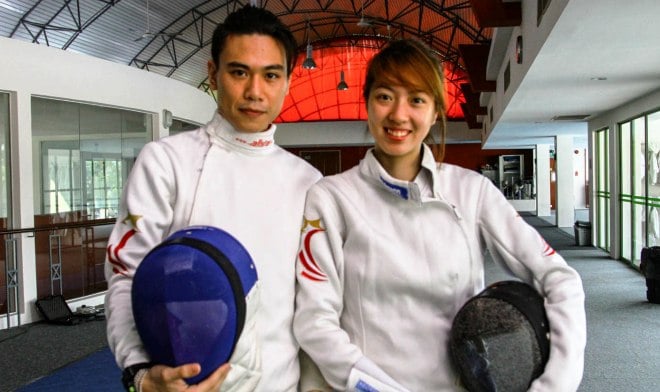Intro to Fencing: Renaissance martial arts

Team Singapore fencers Samson Lee (left) and Cheryl Lim pose for the camera ahead of their Fencing 101 shoot (photo credit: Darren Ho).
By John Yeong
One of just five sports to have graced every edition of the modern Olympic Games, Fencing is a combat sport of European origin that combines artistic elegance with mental endurance and physical speed.
In a recent visit to Toa Payoh Sports Hall, we were fortunate enough to spend some time with two of Team Singapore's fencers: Cheryl Lim and Samson Lee, who gave us a bit more insight into this unique weapons sport. Our curiosity got the better of us so we asked them some questions we felt those who are curious about fencing may be interested to find out.
Why should anyone pick up fencing? Are there any risks involved with using the blades?
Fencing is a sport that provides an intense workout. It requires a substantial amount of endurance, with plenty of leg work and mental strategy during the duel. While fencing involves the use of blades, participants are protected by layers of protection including the head and neck and is generally considered safe with the exception of suffering a few bruises from time to time.
Watch our Fencing for Beginners video with Team Singapore fencer Samson Lee as he demonstrates 3 basic moves in fencing.
There are many moves in fencing both for attacking and defending, but while some of the more advanced techniques that involve feinting, parrying and ripostes may take time to learn, the common ready position or “En Garde”, “Lunge” for attacking, and basic footwork in moving forward and backwards are easy to learn.
a. En Garde: Known as the ready position, you first hold up your master arm (holding the weapon) at a 90 degree angle to your body, leaving just enough space to insert a “thumbs up” between your elbow and your body. Legs should be about one and a half steps apart, with your front knee aligned to your toes.
b. Moving forward/backward: When moving about during a bout, quick recovery of your steps between movements is important. To begin when moving forward, your trailing foot always follows in recovery position after your leading foot. The same applies in reverse when moving away from an attacker.
c. The Lunge: Extend your master arm with the weapon forward, and this is quickly followed by your legwork, with your front leg pushing off and your back leg kicking forward to propel you toward your opponent.
Team Singapore fencer Cheryl Lim talks us through some of the common equipment used in fencing in our Intro to Fencing video here.
How many types of fencing are there? What are the types of equipment used when fencing?
Modern fencing generally involves three weapon types: the foil, épée, and sabre.
The Foil is a light thrusting weapon targeting the torso, neck, groin, and back, but not the arms. Points are scored only with the weapon tip (tip needs to be compressed), while hits using the side of the blade do not count.
Épée similarly is a thrusting weapon, albeit heavier and also targets the whole body. All hits must be with the tip but not the sides of the blade.
Sabre is a light cutting and thrusting weapon that targets the entire body above the waist, excluding the hands. Hits with the edges of the blade or the point are valid.
Masks protect the fencer’s head and neck during duels, but different masks are used depending on weapon classes. In electrical fencing, sabre masks must be able to conduct electricity in order for points to be scored, while for foil and épée masks insulated fabric is used instead.
Fencers generally also wear body suits made of cotton or nylon, while lamé jackets are also worn on top of these suits for sabre or épée fencing.
How do I hold a fencing sword?
A “pistol grip” is generally adopted when holding a épée or foil sword as it allows for stronger blade movements. Watch our video on Intro to Fencing to find out how to adopt a pistol grip. For sabre fencing, the bell guard of the sword is curved around the fencer’s wrist to protect him/her from accidental cuts, and the fencer generally adopts a grip with the thumb straight and the rest of the fingers curved around the handle and wrist slightly bent upwards.
To learn more about fencing, watch a demonstration on épée fencing by our Team Singapore fencers Cheryl Lim and Samson Lee in our Art of Fencing video here below.
To receive the latest updates on the happenings in the Singapore sports scene, or to find out more about some of the latest programmes on offer at ActiveSG, like our Facebook page here.




![ActiveSG Academies and Clubs Logo (Solid Colour)[8647]](https://www.activesgcircle.gov.sg/hs-fs/hubfs/ActiveSG%20Circle%202023Theme/images/ActiveSG%20Academies%20and%20Clubs%20Logo%20(Solid%20Colour)%5B8647%5D.png?width=150&height=65&name=ActiveSG%20Academies%20and%20Clubs%20Logo%20(Solid%20Colour)%5B8647%5D.png)



-01.png?width=200&height=141&name=Team%20Singapore%20Logo%20(Red)-01.png)



